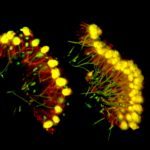Lien vers Pubmed [PMID] – 40925329
Lien DOI – 10.1016/j.cub.2025.07.036
Curr Biol 2025 Sep; 35(17): R828-R829
Cell motility is fundamental to eukaryotic life. Two main modalities exist in animal cells: swimming (via flagellar beating) and crawling (via actin-powered deformations of the cell body)1. Swimming and crawling are present across opisthokonts, including in choanoflagellates, the sister group of animals2. A third type of cell motility, named gliding, is known outside opisthokonts and is defined as locomotion over a surface without visible cell deformation3. Gliding can be mediated by the cell body (for example, in diatoms4) or by the flagellum (for example, in Chlamydomonas5). Here, we show that choanoflagellates engage in gliding motility under mild confinement. Choanoflagellate gliding is abolished by flagellum ablation and by treatment with chemical inhibitors of intraflagellar transport (IFT), suggesting that it is mediated by flagella and requires IFT. Gliding is conserved in at least two choanoflagellate species – Choanoeca flexa and Salpingoeca rosetta. These findings expand the known motility repertoire of choanoflagellates and enrich our understanding of the evolution of cell motility.

